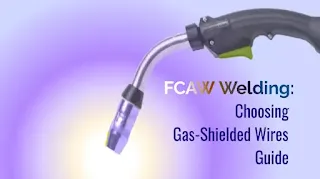FCAW Welding: Choosing Gas-Shielded Wires Guide
Flux-Cored Arc Welding (FCAW) is a versatile and widely used welding technique that offers high-quality welds across various applications.
One crucial aspect of FCAW welding is the selection of the right gas-shielded wires, which play a significant role in achieving optimal results.
In this comprehensive guide, we'll delve into the key factors to consider when choosing gas-shielded wires for FCAW welding, helping you master the art of FCAW welding.
Understanding Gas-Shielded Wires for FCAW Welding
Gas-shielded wires are at the heart of FCAW welding, ensuring the quality, strength, and integrity of the welded joints. These wires consist of a tubular core filled with metallic and metallic-oxide powders.
During welding, these powders act as a flux, creating a protective slag that covers the weld, shielding it from oxidation and impurities. This slag not only safeguards the weld from external contaminants but also aids in purifying the weld pool, resulting in seamless and defect-free welds.
Choosing the Right Shielding Gas
Unlike self-shielded FCAW wires, gas-shielded wires require an external shielding gas to ensure the weld's protection and quality. Depending on the specific wire and desired welding characteristics, you can opt for either 100 percent carbon dioxide or a blend of 75-85 percent argon and carbon dioxide.
While the use of an external shielding gas might seem like an added step, it significantly enhances the usability of gas-shielded FCAW wires compared to their self-shielded counterparts.
READ: Understanding Shielded Metal Arc Welding
Factors Affecting Usability
The American Welding Society (AWS) defines usability as the ease of applying a welding filler metal to create a sound weld.
Several factors contribute to the overall usability of gas-shielded wires, including arc force, penetration, puddle fluidity, spatter amount, ease of slag removal, and bead appearance. Balancing these factors is vital to achieving optimal welding results.
Understanding Wire Classifications
Gas-shielded wires are classified under AWS specifications, such as AWS A5.20 for Carbon Steel Electrodes and AWS A5.29 for Low-Alloy Steel Electrodes. These classifications include codes like E70T-12C and E81T1-Ni1MJ H8, with numbers following the "T" indicating usability designators.
These designators group electrodes with similar flux or core components and usability characteristics, aiding in selecting the right wire for your needs.
Differentiating Mild Steel FCAW-G Wires
Mild steel FCAW-G wires classified under AWS A5.20 with usability designators like 1, 9, or 12 (T-1, T-9, and T-12 wires) are commonly used in various industries. All these wires share a rutile-based (titanium dioxide) slag that contributes to their performance.
While these wires offer excellent usability traits, differences exist in their chemical and mechanical property requirements, affecting their welding characteristics.
READ: TIG (GTAW) shielding gas - various types and characteristics
Optimizing Performance and Usability
The balance between mechanical properties and usability is critical when selecting FCAW-G wires. Wires with superior mechanical properties may weld differently due to the compounds used for enhanced performance.
Manufacturers continually explore innovative formulation techniques to improve this balance, ensuring both robust mechanical properties and ease of use.
Exploring Wires with Basic Slag Systems
Certain wires, labeled with a 5 designator, boast exceptional toughness among FCAW-G classifications. These wires feature a basic slag system, utilizing chemically basic elements like calcium fluoride.
The result is lower oxygen contribution to the weld metal, enhancing toughness. T-5 wires also offer low-weld deposit diffusible-hydrogen levels, making them ideal for demanding applications where root fusion and hydrogen-induced cracking resistance are crucial.
READ: Welding energy - powering the fusion of precision and efficiency
Making Informed Choices
In conclusion, making informed choices in selecting gas-shielded wires for FCAW welding is essential. Assess the demands of your application, prioritize mechanical properties when necessary, and experiment with different wire classifications to find the best fit.
Recognize that not all wires are equal, and manufacturers' approaches to usability vary. Opting for the optimal wire, while considering its characteristics, ensures top-notch welding results.
Reference
AWS A5.20/A5.20M:2015, Specification for Carbon Steel Electrodes for Flux-Cored Arc Welding, paragraph B7. Miami, Fla.: American Welding Society.

